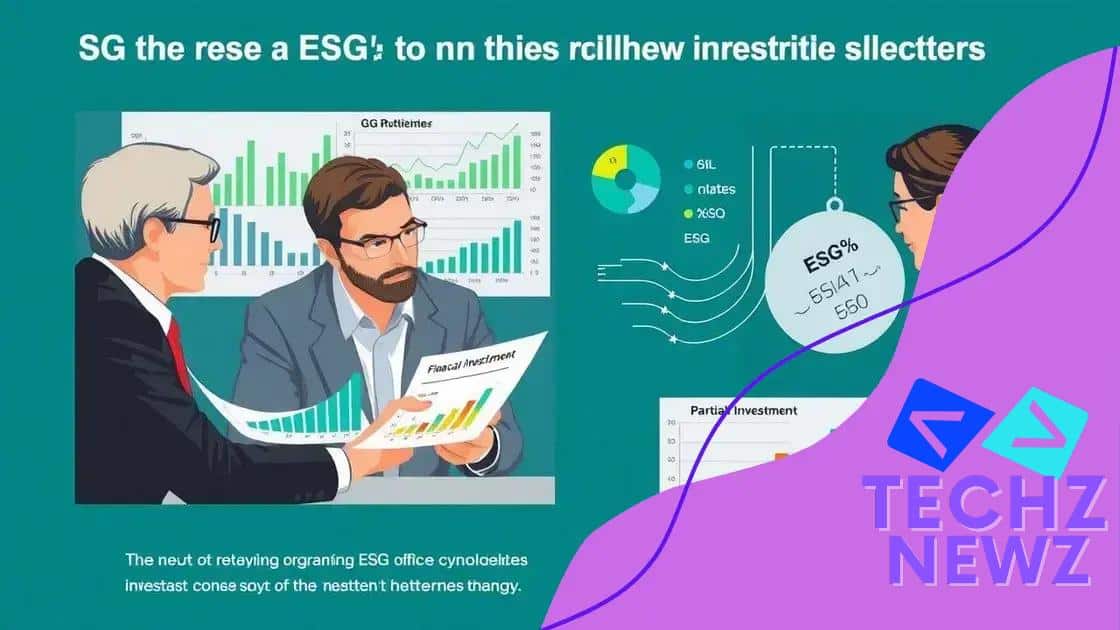ESG investing and its return on investment: a modern approach

ESG investing integrates environmental, social, and governance factors into investment decisions, promoting sustainable practices while potentially enhancing financial returns.
ESG investing and its return on investment are gaining traction as more individuals seek to align their values with their financial decisions. Curious about how this approach can shape your investment strategy? Let’s dive in.
Understanding ESG investing
Understanding ESG investing is essential for anyone looking to embrace modern finance. This approach integrates environmental, social, and governance factors into investment decisions. By doing so, investors can align their portfolios with their values while potentially enhancing returns.
To grasp the concept of ESG investing better, it’s crucial to break down its components.
What are ESG Factors?
ESG factors consider the impact of a company’s operations on the world. Here’s how each component plays a role:
- Environmental: Assesses the company’s efforts towards sustainability, climate impact, and resource management.
- Social: Evaluates how a company treats its employees, suppliers, customers, and the community at large.
- Governance: Focuses on a company’s leadership structure, diversity, rights of shareholders, and ethical practices.
Investors should recognize that these factors can significantly influence a company’s long-term performance. Studies show that incorporating ESG scores can lead to improved risk management and might attract socially conscious investors.
The Growth of ESG Investing
Over recent years, ESG investing has gained prominence. More investors are asking how companies handle their social responsibilities. This shift is not merely a trend but a reflection of changing attitudes toward corporate accountability.
Many investors now see ESG as a way to achieve better financial performance. By focusing on companies with strong ESG practices, investors can potentially mitigate risks related to poor governance or environmental damages.
Key metrics for assessing ESG returns
Evaluating ESG returns requires understanding key metrics that indicate how well investments align with environmental, social, and governance principles. By focusing on these metrics, investors can make informed decisions about their portfolios.
Some of the essential metrics to consider include:
ESG Scores
ESG scores are numerical representations of a company’s performance in each of the three ESG categories. These scores are typically calculated by rating agencies that analyze various factors. A higher score often indicates better sustainability practices and shareholder management.
Carbon Footprint
The carbon footprint of a company measures its total greenhouse gas emissions. By assessing this metric, investors can gain insight into the environmental impact of their investments. Companies working to reduce their carbon footprints may be better positioned for long-term success.
Employee Satisfaction
Employee satisfaction reflects how a company treats its workforce. Metrics such as employee turnover rates and job satisfaction surveys indicate the social health of an organization. Companies with high employee satisfaction are likely to perform better over time.
- High ESG scores signal strong governance practices.
- A lower carbon footprint often correlates with better risk management.
- Happy employees can lead to increased productivity and innovation.
Understanding these metrics is crucial for investors interested in ESG investing. By focusing on measurable outcomes, they can better assess the potential risks and rewards associated with their investments.
As more investors seek to align their portfolios with their values, keeping track of these metrics helps ensure that investments not only yield financial returns but also contribute positively to the world.
The impact of ESG on traditional investment strategies

The impact of ESG on traditional investment strategies is significant and growing. As investors become more socially conscious, they are increasingly looking at how companies address environmental, social, and governance issues.
This shift influences how investors assess risk and return. Traditional strategies that focus solely on financial performance may overlook important non-financial factors. By including ESG criteria, investors can achieve a more comprehensive view of potential investments.
Changing Perspectives
Traditionally, investors prioritized financial metrics like earnings and revenue. However, ESG factors are now being recognized as critical components of overall performance. Companies that engage in sustainable practices often perform better in the long run.
Integration of ESG Factors
Many funds are starting to integrate ESG factors into their investment processes. This includes:
- Screening: Excluding companies that do not meet certain ESG standards.
- Incorporation: Actively investing in companies with high ESG ratings.
- Engagement: Communicating with companies to improve their ESG practices.
This integration allows investors to mitigate risks related to environmental disasters, social unrest, and governance failures. Companies that fail to address these issues may face regulatory penalties and reputational damage, affecting their financial stability.
Moreover, understanding the correlation between sustainability and business performance can lead to better long-term investment outcomes. By incorporating ESG into investment strategies, investors are moving toward a future where profit and responsibility go hand in hand.
Real-world examples of ESG investors
Real-world examples of ESG investors showcase the effectiveness of integrating environmental, social, and governance factors into investment strategy. Many organizations and individual investors have successfully implemented ESG principles to drive positive change while achieving financial returns.
One notable example is BlackRock, one of the world’s largest asset management firms. They have committed to sustainable investing by increasing their investments in companies with strong ESG practices. By influencing corporate behavior, BlackRock is showing how big investors can push for better environmental and social outcomes.
Examples of Successful ESG Funds
Another example includes the Parnassus Core Equity Fund. This fund focuses on companies with strong ESG records and has consistently outperformed traditional funds. By selecting stocks based on sustainability criteria, they have demonstrated that considering ESG leads to solid financial performance.
Case Studies of Companies Embracing ESG
Take Tesla as another interesting case. Their focus on renewable energy and electric vehicles aligns perfectly with sustainable investing trends. As a result, they have attracted ESG-focused investors who value their commitment to environmental stewardship.
- A large pension fund in Norway divested from fossil fuels, demonstrating a shift towards more sustainable investments.
- Many mutual funds now incorporate ESG criteria, reflecting the growing demand for responsible investment options.
- Consumer goods companies like Unilever have made significant strides in improving their sustainability practices, appealing to ESG investors.
These real-world instances illustrate that ESG investing is not just a trend but a viable strategy for achieving better outcomes in finance and our world. With growing awareness and demand for ESG investments, more investors are likely to follow suit and integrate these principles into their strategies.
Challenges and considerations in ESG investing
Challenges and considerations in ESG investing are important for potential investors to understand. While this approach aims to create a more sustainable and ethical financial landscape, it is not without hurdles that need to be addressed.
One primary challenge is the lack of standardized metrics. Different organizations often use various criteria to assess ESG performance, leading to inconsistencies. This can make it difficult for investors to compare companies effectively.
Data Reliability and Transparency
Another significant issue is the reliability of ESG data. Many companies self-report their ESG initiatives, which can sometimes lead to biased or inflated results. Without third-party verification, investors may be making decisions based on incomplete or misleading information.
Cost Concerns
Investing with an ESG focus may also come with higher management fees. Funds that specialize in ESG investments may require more research and monitoring, which could increase costs. Investors must weigh these costs against potential returns.
- The evolving regulatory landscape can create uncertainty for ESG investors.
- Short-term performance may not reflect long-term ESG benefits, making it harder to justify these investments.
- Identifying truly sustainable companies amid ‘greenwashing’ claims is a growing concern.
Despite these challenges, the interest in ESG investing continues to rise. As awareness around social responsibility grows, more companies are adjusting their practices. Investors who navigate these complexities can contribute to a more responsible economy while seeking financial gains.
In conclusion, ESG investing presents both opportunities and challenges for today’s investors. Emphasizing environmental, social, and governance factors not only aligns investments with personal values but can also lead to sustainable financial returns. However, potential investors should remain aware of the complexities involved, such as data reliability and cost considerations. As the focus on sustainability continues to grow, understanding the implications of ESG investing becomes increasingly essential. By navigating these challenges, investors can positively impact the world while achieving their financial goals.
FAQ – Frequently Asked Questions about ESG Investing
What is ESG investing?
ESG investing is an investment strategy that considers environmental, social, and governance factors alongside financial performance.
How can ESG factors affect investment returns?
Incorporating ESG factors can potentially lead to better long-term financial performance, as companies with strong ESG practices may be more resilient to risks.
What are some challenges of ESG investing?
Challenges include the lack of standardized metrics, data reliability issues, and potential higher management fees for ESG-focused funds.
Why is ESG investing becoming more popular?
There is a growing awareness of social responsibility among investors and a desire to align investments with personal values, leading more people to consider ESG factors.





